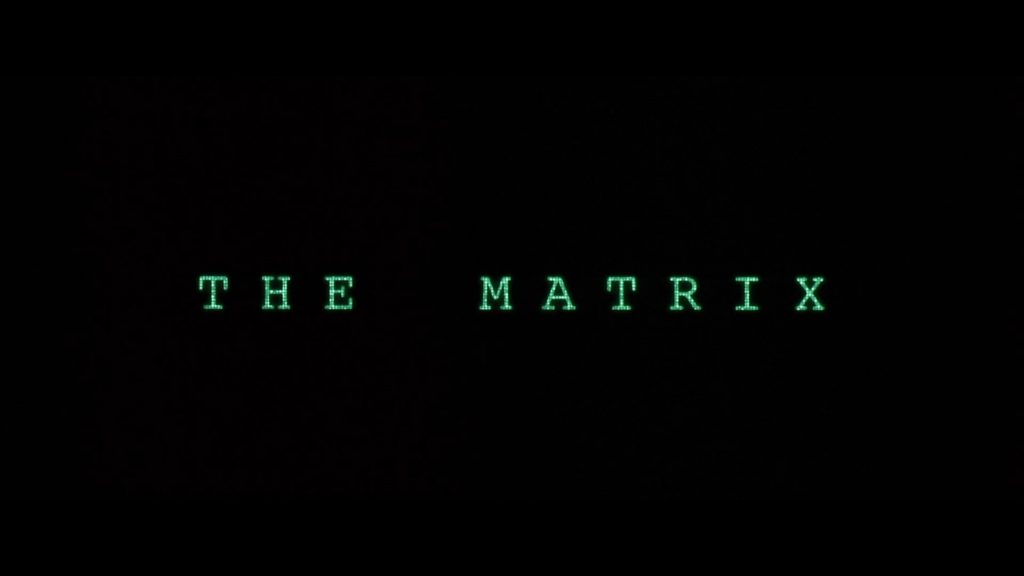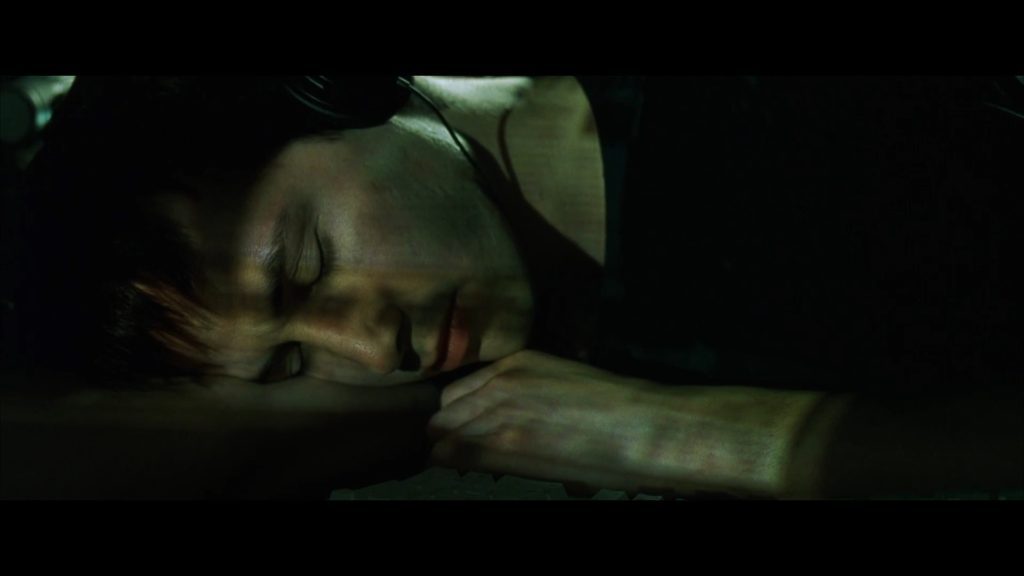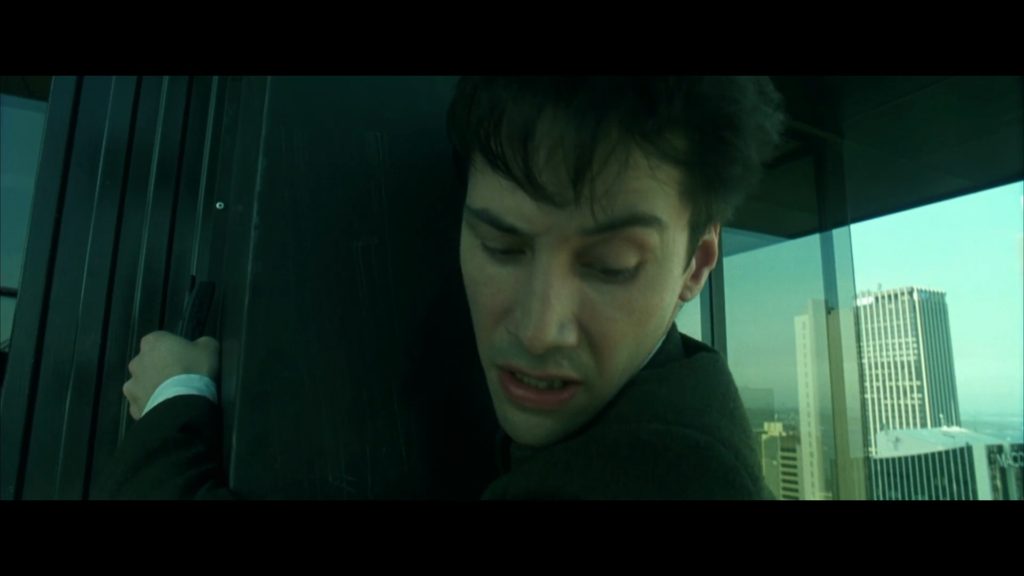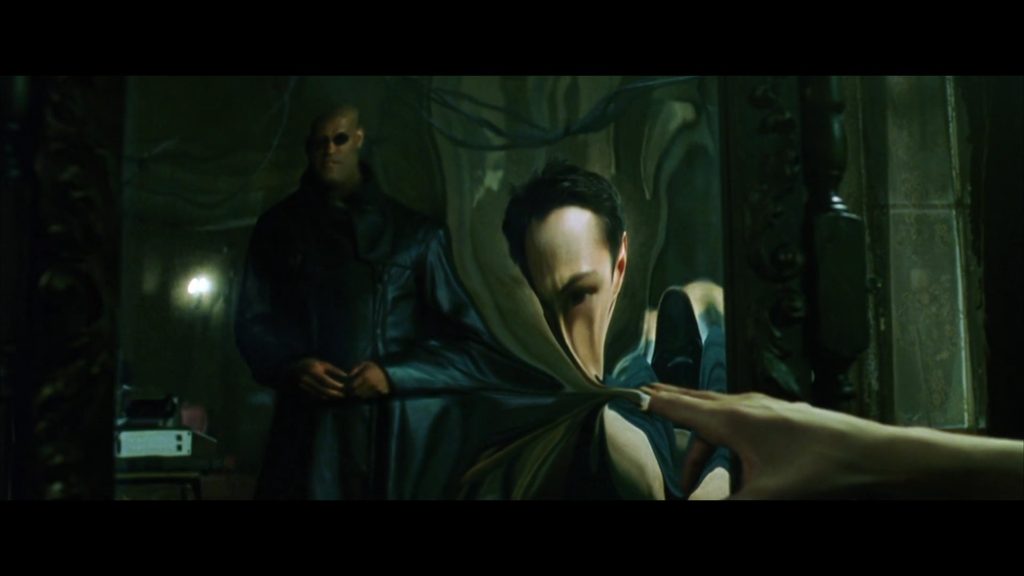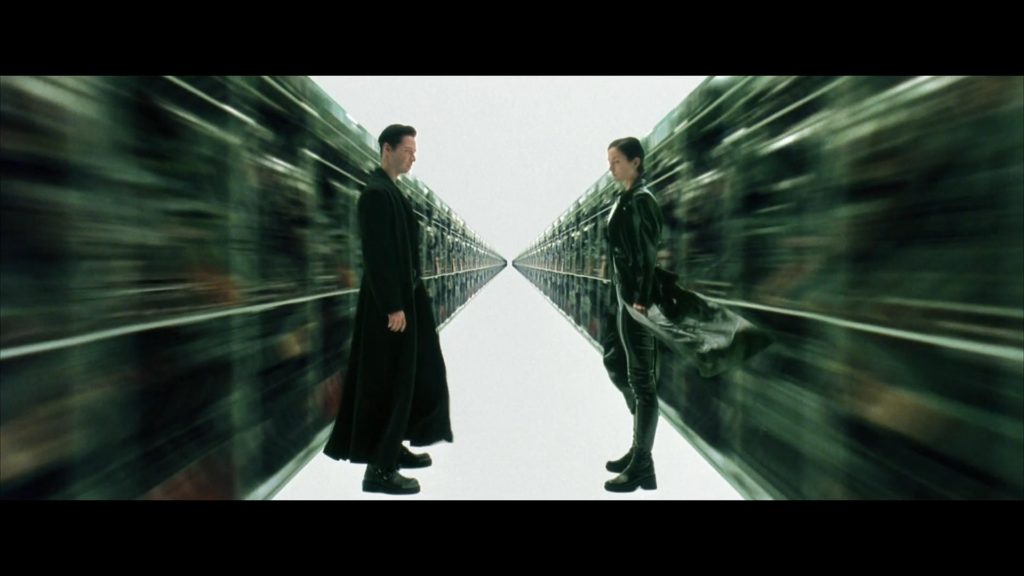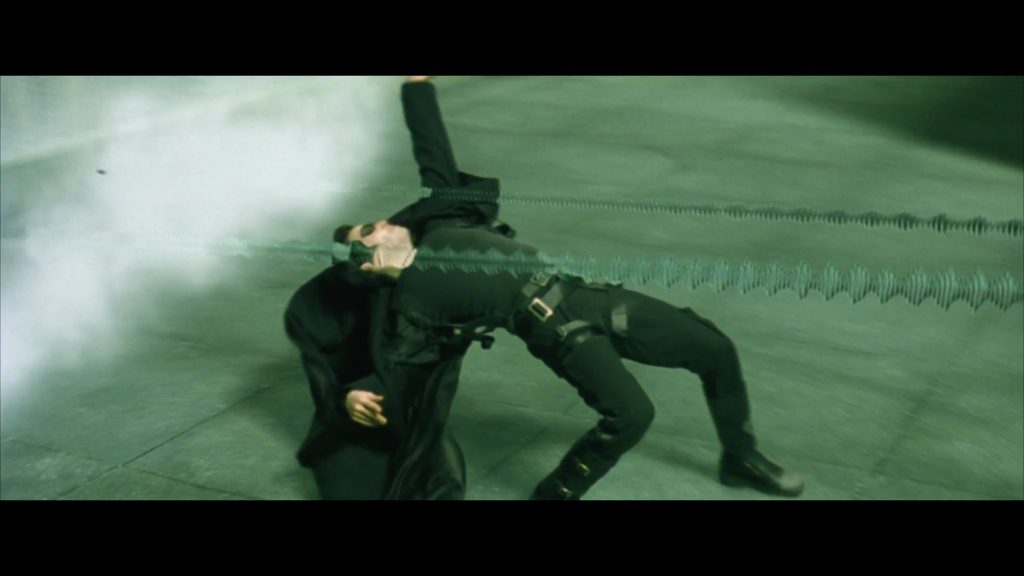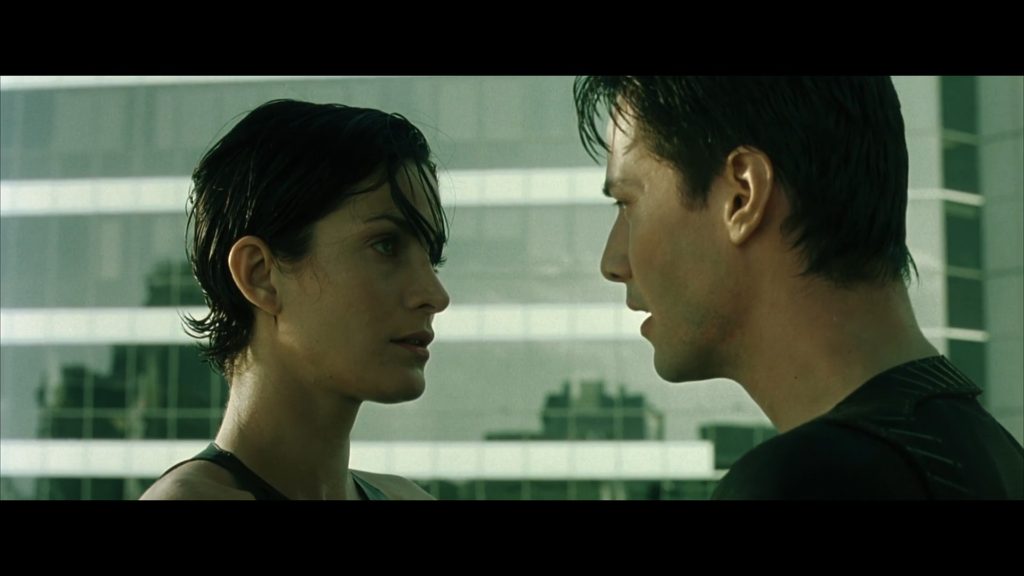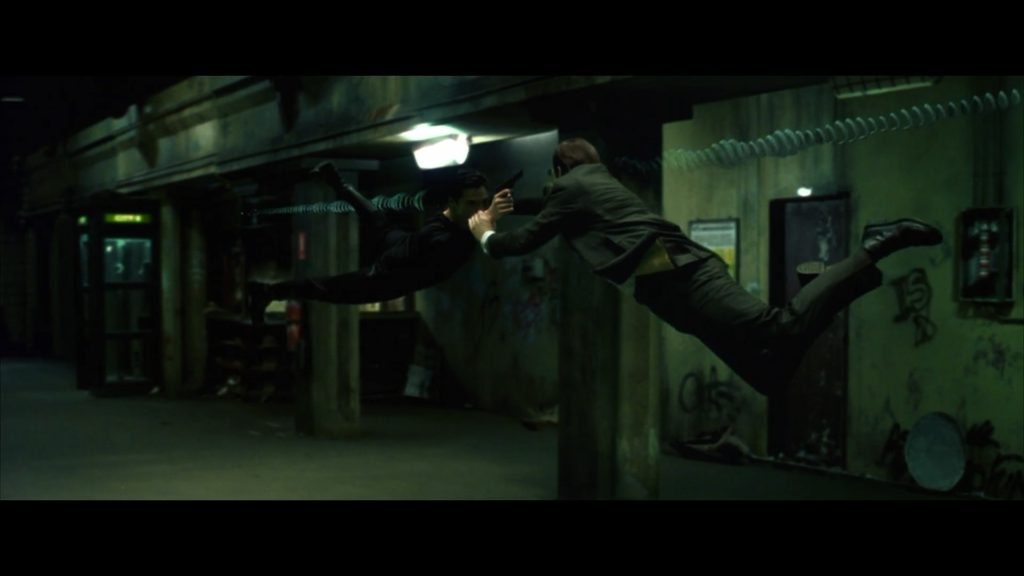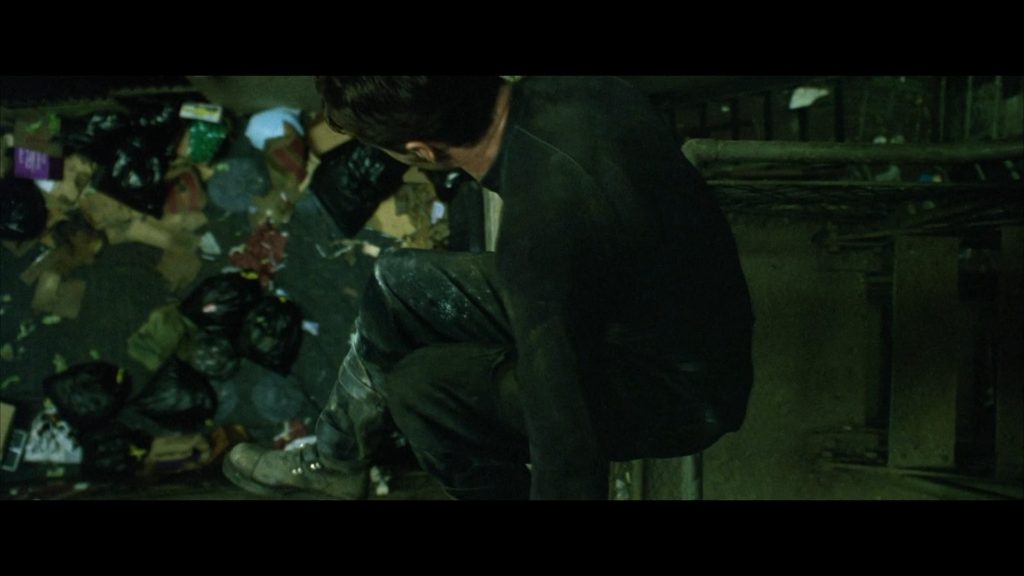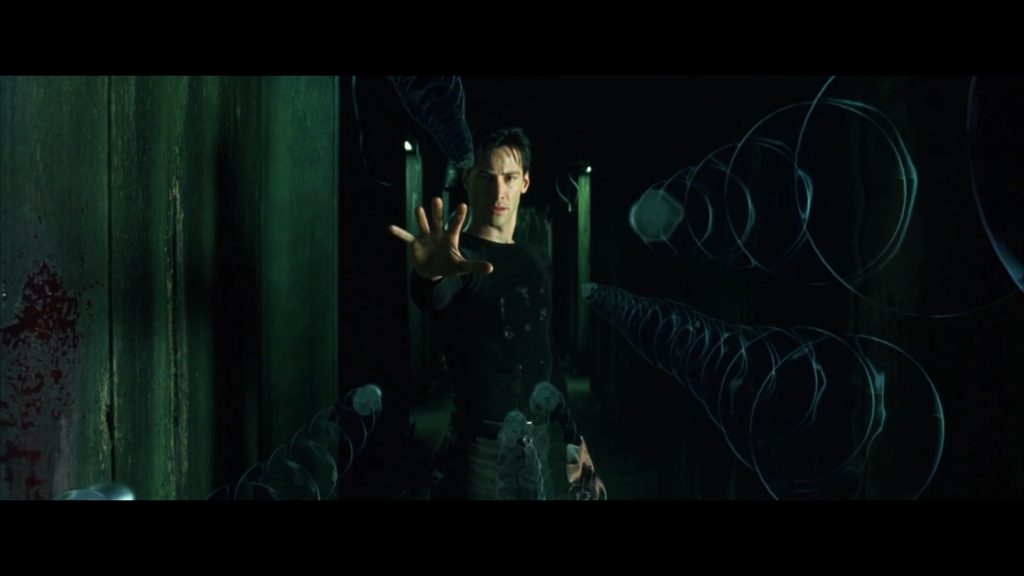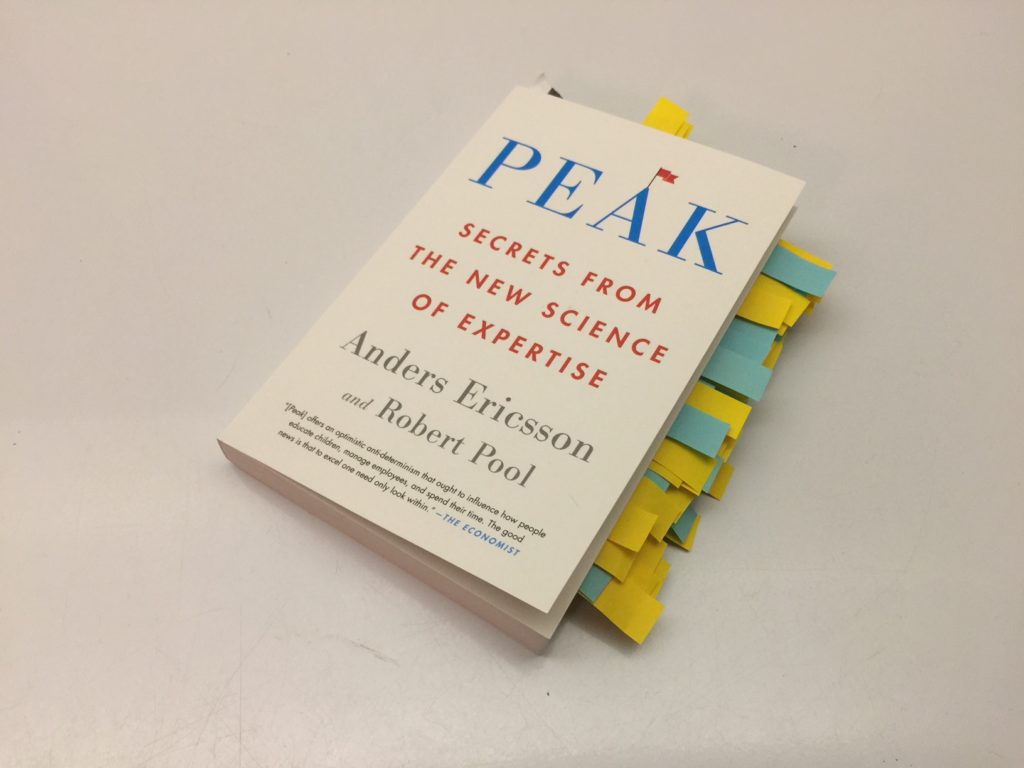Let’s start with the numbers. The Matrix has 75 scenes and there are 5 major characters: Neo, Morpheus, Trinity, Agent Smith, and Cypher. The film follows the hero’s journey archetype to a T, so I’m using the hero’s journey model as outlined in my post here.
Setting the Stage
Morpheus believes he is the One (0:44)
Trinity and Cypher talk about monitoring Neo while the machines try to trace their location.
- This is an extraordinarily elegant scene. It avoids the film faux-pas of having a narrator drone out backstory (or even worse, making the audience read a summary), while still explaining all the critical story elements in less than 40 seconds.
- The exposition is kept interesting by presenting it through a conversation. It earns bonus points by having the conversation between people who disagree.
The Agents and police chase Trinity (1:27)
The police and Agents find Trinity and she must fight her way to the exit from the Matrix
- This scene finishes the work that the opening dialogue started, introducing the villains, superpowers, and key features of the world (such as the exits in and out of the Matrix).
Key Takeaways:
- Conversations are better expositors than description, especially if there’s an interesting social dynamic between the speakers.
- Don’t be afraid to start the story without the main character and introduce them later.
- Worldbuilding is best done by using what’s being introduced. Trinity and Morpheus could have simply described the exits in and out of the Matrix, but instead we watch Trinity racing for the ringing phone and disappearing seconds before the hijacked truck pulverizes it.
The Ordinary World
Follow the white rabbit (6:35)
We see Neo in his normal life as a lone hacker. His computer screen tells us he’s searching for Morpheus. Trinity makes contact with him through his computer. Some of Neo’s illegal clients arrive and, heeding Trinity’s advice, he goes with them to a club.
- This part of the story continues to build the world, half with visuals and half with conversation. The atmosphere and objects in Neo’s apartment tell us a great deal about the character. His conversation with his clients fill in any other necessary details.
Key Takeaways:
- Half tell, half show seems to be the magic ratio, and any telling is done by conversation. The Wachowskis alternate the exposition style, and just by swapping between visuals and conversations they avoid the dreaded info-dump. This implies that it’s not that hard to avoid obvious info dumps – even two techniques, properly contrasted, are enough.
- This scene reveals that Neo is on a quest to find the world of adventure. He doesn’t know that’s what he’s doing, but his search for Morpheus (and an answer to his later question, “What is the Matrix?”) drives him out of the ordinary world. I’ve made note of this as a technique – have the hero searching for something related to the world of adventure (probably without knowing the implications of their search), so that they have a clear motivation for entering the world of adventure when it presents itself.
Call to Adventure
Trinity, the Herald (9:42)
Neo is brought to a club by his clients. Trinity meets Neo at the club and tantalizes him with cryptic talk of the Matrix and Morpheus
- In this scene Trinity validates Neo’s questing; she lets him know that he is not alone in hearing the call to adventure, and that there really is a world of adventure which will find him, if he wants it to.
- Trinity helps the story exposition with rapid fire facts, saying that that Neo lives alone, barely eats, barely sleeps, and so on, all in just a few seconds. This is another use of conversation to convey backstory.
- (Side note: Trinity manipulated Neo to get him into the club, so I’m not counting the lady with the white rabbit tattoo as a herald.)
Key Takeaways:
- The slow build-up here pays dividends. We don’t get any real information, just a bunch of questions that compels the audience to learn more. This is a good practice at the start of any story: introduce as many questions as possible so that the reader will keep going to discover the answers.
Refusal of the Call
Awakened by the Alarm (11:57)
Neo’s alarm wakes him up.
Be at your desk (12:05)
Neo is chastised by his boss for arriving late
- This scene wraps up the other half of Neo’s ordinary world by showing his job at a soulless software company.
- Just as Joseph Campbell pointed out, the ordinary world seems pointless after Trinity delivers the Call to Adventure.
At the office (12:55)
A mysterious phone is delivered to Neo. As soon as he opens the package Morpheus calls and warns Neo that the Agents are coming for him. Morpheus tries to guide Neo out of the building, but Neo loses his nerve and is captured.
- Sticking with Campbell a moment longer, the Agents are obvious Threshold Guardians.
- Morpheus’s call to Neo is a comically literal call to adventure, but Neo can’t make the leap of faith that would take him across the first threshold.
Led out by the police (16:47)
Neo is put in a car by the Agents and police. Trinity observes this, is noticed by an Agent, and flees with a curse.
Unable to speak (17:00)
Agent Smith interrogates Neo and tries to coerce him into helping the Agents catch Morpheus. When Neo refuses, they put a tracking bug in him.
- This scene is Neo’s punishment for refusing the Call to Adventure.
Key Takeaways:
- While the Ordinary World should get fleshed out early in the story, it’s fine to keep developing it up until the hero crosses the first threshold.
- This scene followed Joseph Campbell’s description of the Refusal of the Call almost to the letter. I still have doubts about his model for later parts of a hero’s journey, but early on it’s safe to follow the path he laid out.
Crossing the First Threshold
You are the One Neo (21:32)
Neo wakes up after his interrogation as though it was all just a dream. Morpheus calls him, reveals that Neo is the One, and arranges for them to meet.
Brought to Morpheus (22:36)
Trinity and the rest of the Nebuchadnezzar’s crew meet Neo under a bridge and bring him to Morpheus. On the way, they extract the bug the Agents planted
- This scene has a second, near-refusal of the call. Neo almost gets out of the car when Switch demands he take off his shirt, but Trinity convinces him to stay.
He knows more than you can imagine (25:04)
The crew arrives at the building where Morpheus is waiting. Trinity gives Neo advice before the meeting.
- Throughout the film thus far, the Wachowskis have built the character of Morpheus through brief phone conversations and the comments of other characters. This scene puts the final touches on Morpheus’s pre-meeting mystique
Taking the red pill (25:41)
Neo is introduced to Morpheus. Morpheus starts to explain the Matrix and offers Neo a way into the real world. Neo accepts his offer.
- This scene is more or less pure exposition, but due to Laurence Fishburne’s preternatural charisma one barely notices. Yet again, worldbuilding through conversation saves the day.
- This is the moment that Neo crosses the first threshold. It’s a good example of a test of conviction – Morpheus repeatedly warns Neo that his decision to take the red pill is irrevocable and offers an easy way for Neo to refuse. Despite this, Neo decides to follow his destiny as the hero.
“Kansas is going bye-bye.” (29:51)
Morpheus leads Neo to the next room, where the rest of the crew is preparing for his awakening. The illusion of the Matrix begins to collapse and Neo wakes up in the real world.
Waking up (32:26)
Neo wakes up in his pod. He forces his way out and sees the horror of the human-battery fields. A machine comes and ejects him from his pod, after which the Nebuchadnezzar picks him up.
- In Joseph Campbell’s model for the hero’s journey, this would be the ‘Belly of the Whale’ event.
“Welcome . . . to the real world.” (35:02)
Neo is lifted into the Nebuchadnezzar. The crew picks him up, and Morpheus welcomes Neo to the real world.
“Why do my eyes hurt?” (35:22)
Morpheus and the crew rebuild Neo’s atrophied body.
- Through snippets of conversation (are you sensing a theme?) the Wachowskis continue to flesh out the world.
“More important than what, is ‘when?’” (36:39)
Neo wakes up in a cabin and discovers the plugs installed across his body. Morpheus arrives and explains that they’re in the far future. He tells Neo to come with him for more answers.
“This is my ship, the Nebuchadnezzar.” (37:52)
Morpheus shows Neo around the ship and introduces the crew.
Humans are batteries (39:24)
Morpheus brings Neo into a computer program and explains the Matrix. Neo panics and blacks out.
- Yet more exposition through conversation.
“I can’t go back, can I?” (44:23)
Morpheus explains the prophecy of the One, then tells Neo to prepare for his training.
Key Takeaways:
- It’s ok for the hero to doubt their choice more than once. While there should probably be a primary Refusal of the Call, overcoming the main Refusal doesn’t mean all the hero’s fears are assuaged. They may continue to have doubts all the way until they cross the first threshold.
- All it takes to make a character mysterious is to have other characters speak highly of them while the audience has little-to-no direct contact.
- Tests of conviction are an evergreen way to Cross the First Threshold.
- Conversation is the Swiss army knife of worldbuilding.
Supernatural Aid
Neo meets Tank (46:36)
Tank introduces himself to Neo and explains the last human city, Zion.
- Exposition through conv- oh, you get the point.
“I know Kung Fu.” (47:53)
Tank uses Neo’s brain-jack to upload martial arts knowledge.
- Rather than traditional supernatural aid, such as a magic item, Neo is aided by the Nebuchadnezzar’s ability to upload knowledge and skills directly to his mind.
“Show me.” (48:46)
Morpheus brings Neo into a sparring program and the two do battle. Through their combat and brief lectures, Morpheus shows Neo how to start bending the reality of the Matrix.
- This scene shows the audience the supernatural aid Neo received before he has to use it for real.
“Tank, load the Jump program.” (53:33)
Morpheus takes Neo into the Jump program and challenges him to leap between two distant buildings. Morpheus does it himself, proving it’s possible, but when Neo tries he loses faith in himself and falls painfully to the ground.
- This scene sets an important boundary – Neo’s supernatural aid has made him a badass, but he still has a long way to go before he can defeat the villain and finish his journey.
“Everybody falls the first time.” (54:51)
The rest of the crew has been watching Neo’s training with Morpheus. There’s some concern over Neo’s failure to make the jump, but they generally agree that ‘everybody falls the first time.’ When Neo jacks out of the training program he realizes he’s injured, and Morpheus explains that any injuries suffered in the Matrix are also suffered in real life. Neo asks if dying in the Matrix means dying in the real world, and Morpheus confirms.
- It’s critical for the hero to face consequences for their failures. This scene inflicts a consequence on Neo for failing to make the jump and ensures the audience knows that failure in the Matrix can be lethal.
Cypher is a prick (55:36)
Trinity brings Neo food but finds him asleep. Cypher confronts her outside of Neo’s room and tries to sow doubt that Neo is the One, but Trinity decides to trust Morpheus.
Probably the best movie scene of the decade (56:31)
Morpheus and Neo walk down a busy street while Morpheus describes the Matrix. Neo is distracted by a woman in a red dress, who turns into an Agent when he looks away. Morpheus freezes the program, revealing that it’s all a training program, and explains that everyone who is still plugged into The Matrix can potentially become an Agent. He tells Neo that it’s impossible for any human to fight against the Agents, but that as the One, he will one day be able to defeat them.
- I promised myself I wouldn’t mention it again, but I just have to say it: nearly all the exposition in this film is done through conversation and it never once feels forced. Until I discover a better technique, I’m going to make conversation my default mode of worldbuilding.
Key Takeaways:
- It’s fine (perhaps even a best practice) to have the hero’s Supernatural Aid make them a badass. However, one should be careful not to imply they have nothing further to learn. A simple way to accomplish this is to have the character fail a major test shortly after receiving their aid.
Tests, Allies and Enemies
Sentinels hunt the Nebuchadnezzar (59:00)
In the real world, squid-like machines search for the Nebuchadnezzar. Morpheus hides the ship and Trinity explains to Neo that their only weapon against their pursuers is the EMP. The machines eventually pass them by.
- This scene is a Chekhov’s gun for the time pressure that the heroes will face later on. Once the audience sees the sentinels hunting the ship, they know that at some point the machines will find it.
Neo talks with Cypher (1:01:12)
Neo meets Cypher at the watch station. Cypher quickly hides what he’s been working on and they talk about the Matrix. Cypher admits that he wishes he could go back into the Matrix. Cypher mocks the idea of the One and tells Neo that he should run if he sees an Agent.
Cypher meets with Smith (1:03:42)
Cypher and Agent Smith meet in the Matrix. They make a deal where Cypher will betray Morpheus so that he can be re-inserted into the Matrix.
- This is a type of enemy for the hero to overcome in the Tests, Allies and Enemies part of a story: The Traitor.
- The scene evokes clear themes of trading divine grace for temporal pleasure.
Eating with the Crew (1:05:15)
Neo eats a meal with the crew. Morpheus interrupts and says he’s bringing Neo to see the Oracle
- This scene juxtaposes the succulent steak Cypher was just eating in the Matrix with the slop the crew has to eat in the real world.
Enter the Matrix (1:07:07)
The crew jacks into the Matrix.
Cypher gives away their location (1:07:47)
Cypher makes a call and throws the cell phone into a trash can. This gives away their exit point and allows the machines to set a trap.
- The Traitor makes his move. At any point before this Cypher could have given up his treachery, but at this moment he becomes irredeemable.
Driving through the city (1:08:11)
Our heroes drive through the city on the way to the Oracle’s apartment. On the way Neo reflects on his past life and asks Trinity if she’s spoken to the Oracle. Trinity says she has. Neo asks what the Oracle told her, but they arrive before Trinity can answer.
- Neo examines his ordinary world from his new perspective in the world of adventure. Not every story will have the hero look back so directly, but there may be moments of reminiscence where the hero remembers where they came from.
“I can only show you the door . . .” (1:09:18)
Morpheus and Neo ride the elevator to the Oracle’s apartment. On the way Neo asks about the Oracle and what she told Morpheus. Morpheus says she told him that he would find the One. They arrive at the apartment, and Morpheus tells Neo that he must be the one to open the door.
- Neo faces another test of resolve. It turns out to be anticlimactic, but he still must choose to move forward.
“There is no spoon” (1:10:40)
The door opens from the inside the moment Neo turns the doorknob. An assistant to the Oracle welcomes Neo and Morpheus and brings them into a surprisingly ordinary apartment. She tells Neo to wait with a group of children who may one day be released from the Matrix.
Neo meets the Oracle (1:12:43)
Neo is brought into the Oracle’s kitchen. After some conversation about destiny she tells him that he’s not the One, but Morpheus believes he is so strongly that he will sacrifice himself to save Neo. The Oracle says that Neo will have to choose between his life and Morpheus’s.
- The Oracle is the first ally Neo encounters who is not a part of the Nebuchadnezzar’s crew. Her prophesy, while misleading, is what ultimately leads him to victory.
Leaving the Oracle (1:17:24)
Neo meets Morpheus at the entrance to the Oracle’s apartment. Morpheus tells him not to share the Oracle’s prophesy.
- The Wachowskis are forced into a bit of damage control here. If Neo had just told Morpheus what the Oracle prophesied then all the later deaths and disasters could have been avoided, yet Morpheus suddenly insists that Neo keep it to himself. It wouldn’t necessarily be a problem, except that Morpheus has already shared his own prophesy and Trinity seemed willing to before they were interrupted. So note to self: when telling a story where the hero must keep a prophesy secret, make sure there’s a good reason for them to do so.
The trap is sprung (1:17:49)
Morpheus, Trinity, Neo and Cypher arrive back at the exit point. Cypher seems pleased about something as they get out of the car. Neo experiences deja-vu as they climb the stairs. The crew is alarmed and Trinity explains that deja-vu happens when the machines change something in the Matrix. The crew discovers that all the windows in the building have been replaced by brick. Mouse is killed by SWAT. Morpheus calls Tank and with his help finds them a hiding place inside the walls.
Here’s another challenge for the hero to face: Hiding. When attacked by an overwhelming force, the hero may have no choice but to hole up and hope the danger passes them by.
“They’re in the walls!” (1:21:25)
Cypher sneezes and reveals their hiding place. An Agent grabs Neo through the wall and Morpheus leaps out to protect him. He orders them all to run while he holds off the Agent. Trinity drags Neo away and they escape into the sewers.
Morpheus fights Smith (1:22:44)
Morpheus battles Smith, but despite all his skill is overwhelmed and captured.
- When mentors face villains, they always lose. Always. But their defeat pushes the hero forward in their journey, so their sacrifice is ultimately worth it. This is another crisis for the hero to face during the Test, Allies and Enemies part of a story: The Mentor Fights The Villain.
Cypher calls for an exit (1:25:05)
Cypher calls Tank and asks for an exit point. Tank is suspicious as to why Cypher is not with the others, but gives him the location.
Trinity calls for an exit (1:25:31)
Trinity calls Tank. Neo asks if Morpheus is still alive and Tank confirms he is. Tank gives them the same exit point he just gave Cypher.
Cypher’s betrayal (1:25:46)
Cypher arrives at the exit point first and returns to the real world. He gets a weapon, incapacitates Tank, and kills Dozer.
At the mercy of a madman (1:26:39)
Neo tries to exit the Matrix but the line goes dead. Trinity calls the ship and Cypher answers. Cypher rants about his grievances, real and imagined. He starts pulling the plug on the other crew members, killing them one by one. He’s about to kill Neo when Tank intervenes and kills him.
- Not all forms of torture involve physical pain inflicted on the hero. While it takes an indirect form (watching his friends be killed one by one), this scene is another challenge for the hero to face: Tortured!
Leaving the Matrix (1:30:52)
Tank re-establishes their exit and Trinity returns to the real world. (We don’t see Neo leave, but it’s implied.)
Morpheus’s interrogation begins (1:31:27)
Morpheus is handcuffed to a chair while Smith monologues about a previous form of the Matrix and human psychology. Another Agent injects Morpheus with a truth drug.
- Here we find the last of the challenges in the Tests, Allies and Enemies part of The Matrix: A Captured Friend. Someone the hero cares about has been taken by the villain, and the hero must go and rescue them.
A terrible choice (1:33:31)
Aboard the Nebuchadnezzar, Tank explains how the truth drug works. He tells Neo that Morpheus has the access codes to Zion’s mainframe computer, and if an Agent got the codes they could destroy all of humanity. Tank says that they have no choice but to unplug Morpheus before that happens.
The Agents converse (1:34:27)
The Agents realize that Cypher is dead. They don’t know if he managed to kill the crew of the Nebuchadnezzar before he died, but because they can’t change the situation either way they decide to continue with their plan.
Key Takeaways:
- If it’s worth doing once, it’s worth doing a lot. Neo has to repeatedly prove his determination to move forward on the hero’s journey, and the audience loves him for it
- Related to the above, Neo is constantly tested through choices. Does he meet with Morpheus? Does he take the red pill? Does he sacrifice Morpheus to protect himself? This suggests that a powerful technique for showing a hero’s virtue is to force them to make a series of difficult decisions
- I don’t buy all of Campbell’s archetypal symbolism, but it’s hard to ignore the blatant themes evoked when Cypher trades his freedom for worldly pleasure.
- We can add three types of challenges to our toolbox: Hiding, Tortured!, and A Captured Friend. We also have an ally, The Oracle, and an enemy, The Traitor.
Approach to the Inmost Cave
Neo chooses (1:34:36)
Tank is reluctantly preparing to unplug Morpheus when Neo interrupts him. He tells Tank and Trinity about the Oracle’s prophecy and that he’s not the One. Trinity says that can’t be true, but when Neo questions her she won’t say why. Neo and Trinity jack back into the Matrix to save Morpheus.
- Neo’s Approach to the Inmost Cave begins with, you guessed it, a choice.
Humans are a virus (1:37:25)
Agent Smith taunts Morpheus with his perception of humanity as a virus.
- For some reason villains are always more vivid and memorable that the often bland heroes whom they serve as foils. Smith is no exception.
“We need guns. Lots of guns.” (1:38:43)
Inside the loading program, Neo asks for lots of guns and Tank delivers. Trinity tells Neo that no one has ever attempted a direct attack against the machines, and Neo says that’s why it’s going to work.
Smith interrogates Morpheus (1:39:12)
Smith sends the other two Agents away so that he can question Morpheus alone. He reveals that he hates being in the Matrix and says that he’s going to kill Morpheus if Morpheus doesn’t give him the codes.
- This scene reveals that Smith, far from the cold inhumanity that characterizes the other Agents, is actually somewhat unhinged. This helps put more time pressure on the heroes – even if Morpheus doesn’t break under the interrogation, Smith might snap and kill him.
Key Takeaways:
- The Approach to the Inmost Cave preps the audience for the upcoming Ordeal. Every scene in this part of The Matrix puts time pressure on the heroes and builds anticipation for what comes next
- The Approach to the Inmost Cave is a good place for the Big Bad to put on a show of villainy before their forthcoming downfall.
The Ordeal
The lobby shootout (1:41:04)
Neo and Trinity get in an enormous gunfight with the police and SWAT forces protecting the building that holds Morpheus.
- If you’ve somehow never seen this scene before- stop reading, open YouTube, and go watch it.
“I think they’re trying to save him.” (1:44:20)
The other two Agents interrupt Smith’s interrogation. Trinity and Neo set up a bomb in the elevator. The Agents tell Smith that the crew is trying to save Morpheus. Trinity and Neo cut the elevator cable and ride it to the top of the building while their bomb falls back down to the first floor. The bomb goes off, setting off the sprinkler system, and Smith tells the other Agents to find and destroy the attackers.
Neo dodges bullets (1:45:54)
Trinity and Neo neutralize the SWAT team on the roof. One of the SWAT team is possessed by an Agent, who confronts Neo. Neo tries to shoot him, but the Agent dodges the bullets. The Agent shoots back and Neo manages to evade all of the bullets except for one, which grazes him and breaks his concentration. The Agent stands over Neo and is about to shoot him when Trinity shoots the Agent from point-blank range. She asks Neo how he was able to dodge bullets like the Agents and he gives a non-answer. Trinity downloads a pilot program from Tank and she and Neo steal the SWAT team’s helicopter.
- This is an important middle step in Neo’s development. The upload training is his first step towards defeating the villain, but it’s not sufficient on its own. It would be jarring for him to move directly from his training to defeating Smith, so the scene gives him another challenge to overcome on his way towards beating the Big Bad.
Saving Morpheus (1:47:45)
Trinity and Neo fly the helicopter to the floor where Morpheus is being kept and use a minigun to kill the three Agents guarding him. Morpheus breaks out of his handcuffs and runs for the helicopter, but the three Agents have taken new bodies and shoot him in the knee just before the jump. Neo leaps out (with a cord tying him to the helicopter) and catches Morpheus. Smith shoots the helicopter and it begins to crash.
- I’m still not certain why the Ordeal always comes before the Showdown with the Villain, but for some reason it does. There’s no real reason that Neo has to battle Smith in the subway. The subway scene is fun, sure, and their fight is more flashy as a one-on-one duel, but it would have made just as much sense for Neo to battle the Agents on his way to save Morpheus. Yet this doesn’t happen. The Ordeal is kept separate and distinct from the Showdown with the Villain, and until I have a better grasp on why I’m just going to make sure to follow that rule.
Saving Trinity (1:50:46)
Neo drops Morpheus on a rooftop and lands a short distance away. He realizes that Trinity is still inside the crashing helicopter and prepares to try to catch the entire vehicle using the cord still tied around his waist. Trinity cuts the cord free and uses it to swing away from the helicopter just before it crashes. Tank says that Neo is the One, and Neo pulls Trinity up to safety.
Key Takeaways:
- The hero’s development should have at least three steps. First they’re trained, then they must use their training, and finally they defeat the villain.
- The Ordeal should push the hero to his limits (and even a bit beyond them), but it does not involve the hero directly confronting the villain
- Movement is good for action. This battle does not get bogged down in one place; first there’s the lobby, then the elevator, then rooftop, then minigunning from the helicopter, and finally the helicopter crash. To keep the action fresh make sure that the battle moves over time.
The Reward
Knowing the path, and walking the path (1:51:38)
At last, Morpheus, Neo and Trinity are all safe. Neo and Trinity exchange a long, passionate look after he pulls her onto the roof. Morpheus asks Trinity if she believes that Neo is the One, and Neo asks Morpheus about the Oracle’s false prophecy. Morpheus explains that the Oracle only told him what he needed to hear.
Key Takeaways
- Trinity is far from a damsel in distress. Still, I can’t help but notice that before the end of his hero’s journey, Neo has to save his one true love.
- If the story involves a prophesy, it can be more interesting when the prophesy is false, or even a lie.
Showdown with the Villain
Escaping after the raid (1:52:16)
Morpheus calls Tank and gets an exit location.
Ordering the Sentinels to attack (1:52:26)
The three Agents find the discarded remains of our heroes’ gear. One says that the Sentinels have located the Nebuchadnezzar and orders them to attack the ship. Agent Smith realizes that the heroes must still be in the Matrix.
In the subway (1:52:56)
Our heroes arrive at the exit location – a payphone in the subway. Morpheus exits, but a homeless man sees him disappear and Agent Smith is alerted. Trinity is about to tell Neo what the Oracle prophesied for her when a train drives through the station and drowns out her words. She decides to exit the Matrix rather than finish and gets out just before Agent Smith shoots her. His bullet destroys the phone, trapping Neo in the Matrix.
“He’s beginning to believe.” (1:54:22)
Neo could flee, but decides to stay and fight. Neo and Smith have a ferocious battle. Smith gradually starts to win and decides to kill Neo by holding him in front of an oncoming train. Neo manages to get free and leaps out of the way. Smith is hit by the train.
- Neo faces two more tests of resolve: first when he decides to stay and fight, and second when he stands up and shakes off the dust after being downed by Smith.
- Smith is killed by his own arrogance, not Neo’s battle prowess.
- Smith has always called Neo by the name he was born with, Mr. Anderson. In this scene Neo repudiates that name and embraces his identity as the hero.
Key Takeaways:
- The battle between Neo and Agent Smith is a masterclass on how to do a Showdown with the Villain. We should make special note of each of these elements:
- Neo stays and fights when he had the option to run away
- Neo shows grit and determination despite battling a superior opponent
- Smith is certain he’s invincible, and Neo uses his arrogance to defeat him
- Through this battle Neo gives up his old self and embraces his identity as a hero
The Road Back
Running from the Agents (1:58:39)
Neo’s victory is short lived – Agent Smith takes a new body aboard the train and stops it. Neo has to run.
- In Joseph Campbell’s model, this marks the start of the Magic Flight
The Sentinels approach (1:58:48)
The Sentinels find the Nebuchadnezzar, leaving Neo only a few minutes to get out of the Matrix before they destroy the ship. Morpheus charges the EMP, but can’t use it while Neo is still jacked in.
“Mr. Wizard, get me the hell out of here!” (1:59:23)
Neo steals a phone and calls Tank, who gives him an exit location. With Tank guiding him Neo flees through streets and buildings, trying to escape the pursuing Agents.
The Sentinels arrive (2:00:58)
The Sentinels reach the Nebuchadnezzar and begin cutting through the hull. Morpheus prepares to set off the EMP and reassures Trinity that Neo is going to make it.
Back where it all started (2:01:34)
The exit is in the same building where the Agents found Trinity at the start of the movie. Smith realizes this and splits off from the other two Agents. Tank gives Neo the room number for the exit and Neo runs for it.
The Sentinels breach the hull (2:02:11)
The Sentinels finish cutting their way into the Nebuchadnezzar and begin wreaking havoc inside.
Key Takeaways:
- This is an almost perfect example of The Magic Flight in Joseph Campbell’s model for a hero’s journey. Our hero Neo has to run like hell from an enraged god and escape back to his (new) ordinary world.
- This escape scene is all about the time pressure. If we want to have a similarly dramatic Road Back in our own stories, we need to make sure that the hero is racing against the clock.
The Resurrection
Neo’s death (2:02:28)
Neo reaches the exit, but Smith got there first. Smith shoots him repeatedly and Neo’s heart stops. Trinity and Morpheus look on in horror. The other two Agents arrive and confirm that Neo is dead.
The Power of Love and . . . well, just Love (2:03:17)
The Sentinels continue to destroy the Nebuchadnezzar. Trinity tells Neo’s lifeless body that the Oracle told her she would fall in love, and that the man she loved would be the One. She says that Neo can’t be dead, because she loves him. She kisses him and his heart starts beating. When she sees this, she orders him to get up.
When you’re ready, you won’t have to (2:04:55)
Back in the Matrix, Neo gets to his feet. The Agents see this and all try to shoot him at once, but with a wave of his hand he freezes the bullets in the air. Neo now sees the Matrix in its raw code. Smith attacks Neo and Neo defeats him effortlessly. He leaps inside of Smith’s body and destroys him from the inside out. The other two Agents flee.
In the nick of time (2:06:55)
Back in the real world, the Sentinels have reached the crew. Trinity shouts for Neo and he rushes to the exit phone. A Sentinel is just about to kill Neo when Morpheus triggers the EMP. The machines drop lifelessly the ground. Neo wakes up and kisses Trinity.
Key Takeaways:
- Despite all the (often justified) criticisms of his work, Joseph Campbell was onto something when he said that heroes grow through death and rebirth. The Matrix is a particularly telling example because Neo’s resurrection appears to be totally incongruent with the rest of the film, if you view the film as dystopian cyberpunk. A kiss brings the hero back from the dead? Come on, what fantasy garbage is this? And yet there’s scarcely a peep of complaint from the audience, because in the context of the hero’s journey, Neo’s miraculous rebirth is completely appropriate.
Return with the Elixir
System Failure (2:07:53)
Neo calls the machines. Like in the beginning of the film the machines try to trace the call, but are met with a sudden system failure. Neo says that he’s going to set humanity free from the machine’s control.
Key Takeaways:
- A minimalist Return with the Elixir seems to be a hallmark of modern stories. Neo doesn’t get a grand feast, or an awards ceremony where everyone gets a medal but the Wookie. We’re left with nothing but hope for a better world, and yet somehow that’s still enough.

